
Crane (machine)
Encyclopedia

Hoist (device)
A hoist is a device used for lifting or lowering a load by means of a drum or lift-wheel around which rope or chain wraps. It may be manually operated, electrically or pneumatically driven and may use chain, fiber or wire rope as its lifting medium. The load is attached to the hoist by means of a...
, wire rope
Wire rope
thumb|Steel wire rope Wire rope is a type of rope which consists of several strands of metal wire laid into a helix. Initially wrought iron wires were used, but today steel is the main material used for wire ropes....
s or chain
Chain
A chain is a sequence of connected links.Chain may also refer to:Chain may refer to:* Necklace - a jewelry which is worn around the neck* Mail , a type of armor made of interlocking chain links...
s, and sheaves
Sheave (mechanical)
A sheave is a wheel or roller with a groove along its edge for holding a belt, rope or cable. When hung between two supports and equipped with a belt, rope or cable, one or more sheaves make up a pulley. The words sheave and pulley are sometimes used interchangeably.A sheave can also refer to a...
, that can be used both to lift and lower materials and to move them horizontally. It uses one or more simple machine
Simple machine
A simple machine is a mechanical device that changes the direction or magnitude of a force.In general, they can be defined as the simplest mechanisms that use mechanical advantage to multiply force. A simple machine uses a single applied force to do work against a single load force...
s to create mechanical advantage
Mechanical advantage
Mechanical advantage is a measure of the force amplification achieved by using a tool, mechanical device or machine system. Ideally, the device preserves the input power and simply trades off forces against movement to obtain a desired amplification in the output force...
and thus move loads beyond the normal capability of a man. Cranes are commonly employed in the transport
Transport
Transport or transportation is the movement of people, cattle, animals and goods from one location to another. Modes of transport include air, rail, road, water, cable, pipeline, and space. The field can be divided into infrastructure, vehicles, and operations...
industry for the loading and unloading of freight, in the construction
Construction
In the fields of architecture and civil engineering, construction is a process that consists of the building or assembling of infrastructure. Far from being a single activity, large scale construction is a feat of human multitasking...
industry for the movement of materials and in the manufacturing industry for the assembling of heavy equipment.
The first construction cranes were invented by the Ancient Greeks
Ancient Greece
Ancient Greece is a civilization belonging to a period of Greek history that lasted from the Archaic period of the 8th to 6th centuries BC to the end of antiquity. Immediately following this period was the beginning of the Early Middle Ages and the Byzantine era. Included in Ancient Greece is the...
and were powered by men or beasts of burden, such as donkeys. These cranes were used for the construction of tall buildings. Larger cranes were later developed, employing the use of human treadwheel
Treadwheel
A treadwheel is a form of animal engine typically powered by humans. It may resemble a water wheel in appearance, and can be worked either by a human treading paddles set into its circumference , or by a human or animal standing inside it .Uses of treadwheels included raising water, to power...
s, permitting the lifting of heavier weights. In the High Middle Ages
High Middle Ages
The High Middle Ages was the period of European history around the 11th, 12th, and 13th centuries . The High Middle Ages were preceded by the Early Middle Ages and followed by the Late Middle Ages, which by convention end around 1500....
, harbour cranes were introduced to load and unload ships and assist with their construction – some were built into stone towers for extra strength and stability. The earliest cranes were constructed from wood, but cast iron
Cast iron
Cast iron is derived from pig iron, and while it usually refers to gray iron, it also identifies a large group of ferrous alloys which solidify with a eutectic. The color of a fractured surface can be used to identify an alloy. White cast iron is named after its white surface when fractured, due...
and steel
Steel
Steel is an alloy that consists mostly of iron and has a carbon content between 0.2% and 2.1% by weight, depending on the grade. Carbon is the most common alloying material for iron, but various other alloying elements are used, such as manganese, chromium, vanadium, and tungsten...
took over with the coming of the Industrial Revolution
Industrial Revolution
The Industrial Revolution was a period from the 18th to the 19th century where major changes in agriculture, manufacturing, mining, transportation, and technology had a profound effect on the social, economic and cultural conditions of the times...
.
For many centuries, power was supplied by the physical exertion of men or animals, although hoists in watermill
Watermill
A watermill is a structure that uses a water wheel or turbine to drive a mechanical process such as flour, lumber or textile production, or metal shaping .- History :...
s and windmill
Windmill
A windmill is a machine which converts the energy of wind into rotational energy by means of vanes called sails or blades. Originally windmills were developed for milling grain for food production. In the course of history the windmill was adapted to many other industrial uses. An important...
s could be driven by the harnessed natural power. The first 'mechanical' power was provided by steam engine
Steam engine
A steam engine is a heat engine that performs mechanical work using steam as its working fluid.Steam engines are external combustion engines, where the working fluid is separate from the combustion products. Non-combustion heat sources such as solar power, nuclear power or geothermal energy may be...
s, the earliest steam crane
Steam crane
A steam crane is a crane powered by a steam engine. It may be fixed or mobile and, if mobile, it may run on rail tracks, caterpillar tracks, road wheels, or be mounted on a barge...
being introduced in the 18th or 19th century, with many remaining in use well into the late 20th century. Modern cranes usually use internal combustion engine
Internal combustion engine
The internal combustion engine is an engine in which the combustion of a fuel occurs with an oxidizer in a combustion chamber. In an internal combustion engine, the expansion of the high-temperature and high -pressure gases produced by combustion apply direct force to some component of the engine...
s or electric motor
Electric motor
An electric motor converts electrical energy into mechanical energy.Most electric motors operate through the interaction of magnetic fields and current-carrying conductors to generate force...
s and hydraulic systems to provide a much greater lifting capability than was previously possible, although manual cranes are still utilised where the provision of power would be uneconomic.
Cranes exist in an enormous variety of forms – each tailored to a specific use. Sometimes sizes range from the smallest jib cranes, used inside workshops, to the tallest tower cranes, used for constructing high buildings. For a while, mini - cranes are also used for constructing high buildings, in order to facilitate constructions by reaching tight spaces. Finally, we can find larger floating cranes, generally used to build oil rigs and salvage sunken ships.
This article also covers lifting machines that do not strictly fit the above definition of a crane, but are generally known as cranes, such as stacker cranes and loader cranes.
Ancient Greece
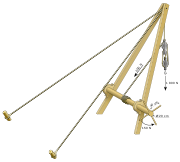
The crane for lifting heavy loads was invented by the Ancient Greeks
Ancient Greece
Ancient Greece is a civilization belonging to a period of Greek history that lasted from the Archaic period of the 8th to 6th centuries BC to the end of antiquity. Immediately following this period was the beginning of the Early Middle Ages and the Byzantine era. Included in Ancient Greece is the...
in the late 6th century BC. The archaeological record shows that no later than c. 515 BC, distinctive cuttings for both lifting tongs and lewis irons begin to appear on stone blocks of Greek temples. Since these holes point at the use of a lifting device, and since they are to be found either above the center of gravity of the block, or in pairs equidistant from a point over the center of gravity, they are regarded by archaeologists as the positive evidence required for the existence of the crane.
The introduction of the winch
Winch
A winch is a mechanical device that is used to pull in or let out or otherwise adjust the "tension" of a rope or wire rope . In its simplest form it consists of a spool and attached hand crank. In larger forms, winches stand at the heart of machines as diverse as tow trucks, steam shovels and...
and pulley
Pulley
A pulley, also called a sheave or a drum, is a mechanism composed of a wheel on an axle or shaft that may have a groove between two flanges around its circumference. A rope, cable, belt, or chain usually runs over the wheel and inside the groove, if present...
hoist soon led to a widespread replacement of ramps
Inclined plane
The inclined plane is one of the original six simple machines; as the name suggests, it is a flat surface whose endpoints are at different heights. By moving an object up an inclined plane rather than completely vertical, the amount of force required is reduced, at the expense of increasing the...
as the main means of vertical motion. For the next two hundred years, Greek building sites witnessed a sharp drop in the weights handled, as the new lifting technique made the use of several smaller stones more practical than of fewer larger ones. In contrast to the archaic period
Archaic period in Greece
The Archaic period in Greece was a period of ancient Greek history that followed the Greek Dark Ages. This period saw the rise of the polis and the founding of colonies, as well as the first inklings of classical philosophy, theatre in the form of tragedies performed during Dionysia, and written...
with its tendency to ever-increasing block sizes, Greek temples of the classical age like the Parthenon
Parthenon
The Parthenon is a temple on the Athenian Acropolis, Greece, dedicated to the Greek goddess Athena, whom the people of Athens considered their virgin patron. Its construction began in 447 BC when the Athenian Empire was at the height of its power. It was completed in 438 BC, although...
invariably featured stone blocks weighing less than 15–20 metric tons. Also, the practice of erecting large monolithic columns was practically abandoned in favour of using several column drums.
Although the exact circumstances of the shift from the ramp to the crane technology remain unclear, it has been argued that the volatile social and political conditions of Greece
Greece
Greece , officially the Hellenic Republic , and historically Hellas or the Republic of Greece in English, is a country in southeastern Europe....
were more suitable to the employment of small, professional construction teams than of large bodies of unskilled labour, making the crane more preferable to the Greek polis
Polis
Polis , plural poleis , literally means city in Greek. It could also mean citizenship and body of citizens. In modern historiography "polis" is normally used to indicate the ancient Greek city-states, like Classical Athens and its contemporaries, so polis is often translated as "city-state."The...
than the more labour-intensive ramp which had been the norm in the autocratic societies of Egypt
Ancient Egypt
Ancient Egypt was an ancient civilization of Northeastern Africa, concentrated along the lower reaches of the Nile River in what is now the modern country of Egypt. Egyptian civilization coalesced around 3150 BC with the political unification of Upper and Lower Egypt under the first pharaoh...
or Assyria
Assyria
Assyria was a Semitic Akkadian kingdom, extant as a nation state from the mid–23rd century BC to 608 BC centred on the Upper Tigris river, in northern Mesopotamia , that came to rule regional empires a number of times through history. It was named for its original capital, the ancient city of Assur...
.
The first unequivocal literary evidence for the existence of the compound pulley system appears in the Mechanical Problems (Mech. 18, 853a32-853b13) attributed to Aristotle
Aristotle
Aristotle was a Greek philosopher and polymath, a student of Plato and teacher of Alexander the Great. His writings cover many subjects, including physics, metaphysics, poetry, theater, music, logic, rhetoric, linguistics, politics, government, ethics, biology, and zoology...
(384–322 BC), but perhaps composed at a slightly later date. Around the same time, block sizes at Greek temples began to match their archaic predecessors again, indicating that the more sophisticated compound pulley must have found its way to Greek construction sites by then.
Ancient Rome

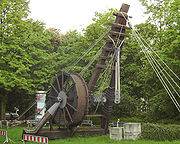
Roman Empire
The Roman Empire was the post-Republican period of the ancient Roman civilization, characterised by an autocratic form of government and large territorial holdings in Europe and around the Mediterranean....
, when construction activity soared and buildings reached enormous dimensions. The Romans adopted the Greek crane and developed it further. We are relatively well informed about their lifting techniques, thanks to rather lengthy accounts by the engineers Vitruvius
Vitruvius
Marcus Vitruvius Pollio was a Roman writer, architect and engineer, active in the 1st century BC. He is best known as the author of the multi-volume work De Architectura ....
(De Architectura 10.2, 1-10) and Heron of Alexandria (Mechanica 3.2-5). There are also two surviving reliefs of Roman treadwheel crane
Treadwheel crane
A treadwheel crane is a wooden, human powered, hoisting and lowering device. It was primarily used during Roman times and the Middle Ages in the building of castles and cathedrals. The often heavy charge is lifted as the individual inside the treadwheel crane walks...
s, with the Haterii
Quintus Haterius
Though we do not know his place of birth, Quintus Haterius was born into a senatorial family around 65 BC. This date is uncertain because we only know the approximate year of his death, and his approximate age at the time...
tombstone from the late first century AD being particularly detailed.
The simplest Roman crane, the trispastos, consisted of a single-beam jib, a winch
Winch
A winch is a mechanical device that is used to pull in or let out or otherwise adjust the "tension" of a rope or wire rope . In its simplest form it consists of a spool and attached hand crank. In larger forms, winches stand at the heart of machines as diverse as tow trucks, steam shovels and...
, a rope
Rope
A rope is a length of fibres, twisted or braided together to improve strength for pulling and connecting. It has tensile strength but is too flexible to provide compressive strength...
, and a block containing three pulleys. Having thus a mechanical advantage
Mechanical advantage
Mechanical advantage is a measure of the force amplification achieved by using a tool, mechanical device or machine system. Ideally, the device preserves the input power and simply trades off forces against movement to obtain a desired amplification in the output force...
of 3:1, it has been calculated that a single man working the winch could raise 150 kg (3 pulleys x 50 kg = 150), assuming that 50 kg represent the maximum effort a man can exert over a longer time period. Heavier crane types featured five pulleys (pentaspastos) or, in case of the largest one, a set of three by five pulleys (Polyspastos) and came with two, three or four masts, depending on the maximum load. The polyspastos, when worked by four men at both sides of the winch, could already lift 3,000 kg (3 ropes x 5 pulleys x 4 men x 50 kg = 3,000 kg). In case the winch was replaced by a treadwheel, the maximum load even doubled to 6,000 kg at only half the crew, since the treadwheel possesses a much bigger mechanical advantage due to its larger diameter. This meant that, in comparison to the construction of the Egyptian Pyramids
Egyptian pyramids
The Egyptian pyramids are ancient pyramid-shaped masonry structures located in Egypt.There are 138 pyramids discovered in Egypt as of 2008. Most were built as tombs for the country's Pharaohs and their consorts during the Old and Middle Kingdom periods.The earliest known Egyptian pyramids are found...
, where about 50 men were needed to move a 2.5 ton stone block up the ramp (50 kg per person), the lifting capability of the Roman polyspastos proved to be 60 times higher (3,000 kg per person).
However, numerous extant Roman buildings which feature much heavier stone blocks than those handled by the polyspastos indicate that the overall lifting capability of the Romans went far beyond that of any single crane. At the temple of Jupiter at Baalbek
Baalbek
Baalbek is a town in the Beqaa Valley of Lebanon, altitude , situated east of the Litani River. It is famous for its exquisitely detailed yet monumentally scaled temple ruins of the Roman period, when Baalbek, then known as Heliopolis, was one of the largest sanctuaries in the Empire...
, for instance, the architrave
Architrave
An architrave is the lintel or beam that rests on the capitals of the columns. It is an architectural element in Classical architecture.-Classical architecture:...
blocks weigh up to 60 tons each, and one corner cornice
Cornice
Cornice molding is generally any horizontal decorative molding that crowns any building or furniture element: the cornice over a door or window, for instance, or the cornice around the edge of a pedestal. A simple cornice may be formed just with a crown molding.The function of the projecting...
block even over 100 tons, all of them raised to a height of about 19 m. In Rome
Rome
Rome is the capital of Italy and the country's largest and most populated city and comune, with over 2.7 million residents in . The city is located in the central-western portion of the Italian Peninsula, on the Tiber River within the Lazio region of Italy.Rome's history spans two and a half...
, the capital block of Trajan's Column weighs 53.3 tons, which had to be lifted to a height of about 34 m (see construction of Trajan's Column).
It is assumed that Roman engineers lifted these extraordinary weights by two measures (see picture below for comparable Renaissance technique): First, as suggested by Heron, a lifting tower was set up, whose four masts were arranged in the shape of a quadrangle with parallel sides, not unlike a siege tower
Siege tower
A siege tower is a specialized siege engine, constructed to protect assailants and ladders while approaching the defensive walls of a fortification. The tower was often rectangular with four wheels with its height roughly equal to that of the wall or sometimes higher to allow archers to stand on...
, but with the column in the middle of the structure (Mechanica 3.5). Second, a multitude of capstans
Capstan (nautical)
A capstan is a vertical-axled rotating machine developed for use on sailing ships to apply force to ropes, cables, and hawsers. The principle is similar to that of the windlass, which has a horizontal axle.- History :...
were placed on the ground around the tower, for, although having a lower leverage ratio than treadwheels, capstans could be set up in higher numbers and run by more men (and, moreover, by draught animals). This use of multiple capstans is also described by Ammianus Marcellinus
Ammianus Marcellinus
Ammianus Marcellinus was a fourth-century Roman historian. He wrote the penultimate major historical account surviving from Antiquity...
(17.4.15) in connection with the lifting of the Lateranense obelisk in the Circus Maximus
Circus Maximus
The Circus Maximus is an ancient Roman chariot racing stadium and mass entertainment venue located in Rome, Italy. Situated in the valley between the Aventine and Palatine hills, it was the first and largest stadium in ancient Rome and its later Empire...
(ca. 357 AD). The maximum lifting capability of a single capstan can be established by the number of lewis iron holes bored into the monolith. In case of the Baalbek architrave blocks, which weigh between 55 and 60 tons, eight extant holes suggest an allowance of 7.5 ton per lewis iron, that is per capstan. Lifting such heavy weights in a concerted action required a great amount of coordination between the work groups applying the force to the capstans.
Middle Ages

High Middle Ages
The High Middle Ages was the period of European history around the 11th, 12th, and 13th centuries . The High Middle Ages were preceded by the Early Middle Ages and followed by the Late Middle Ages, which by convention end around 1500....
, the treadwheel crane was reintroduced on a large scale after the technology had fallen into disuse in western Europe with the demise of the Western Roman Empire
Western Roman Empire
The Western Roman Empire was the western half of the Roman Empire after its division by Diocletian in 285; the other half of the Roman Empire was the Eastern Roman Empire, commonly referred to today as the Byzantine Empire....
. The earliest reference to a treadwheel (magna rota) reappears in archival literature in France about 1225, followed by an illuminated depiction in a manuscript of probably also French origin dating to 1240. In navigation, the earliest uses of harbor cranes are documented for Utrecht
Utrecht (city)
Utrecht city and municipality is the capital and most populous city of the Dutch province of Utrecht. It is located in the eastern corner of the Randstad conurbation, and is the fourth largest city of the Netherlands with a population of 312,634 on 1 Jan 2011.Utrecht's ancient city centre features...
in 1244, Antwerp in 1263, Brugge
Brügge
Brügge is a municipality in the district of Rendsburg-Eckernförde, in Schleswig-Holstein, Germany.Its small church and market square are noted for their beauty....
in 1288 and Hamburg
Hamburg
-History:The first historic name for the city was, according to Claudius Ptolemy's reports, Treva.But the city takes its modern name, Hamburg, from the first permanent building on the site, a castle whose construction was ordered by the Emperor Charlemagne in AD 808...
in 1291, while in England the treadwheel is not recorded before 1331.
Generally, vertical transport could be done more safely and inexpensively by cranes than by customary methods. Typical areas of application were harbors, mines, and, in particular, building sites where the treadwheel crane played a pivotal role in the construction of the lofty Gothic cathedrals
Gothic architecture
Gothic architecture is a style of architecture that flourished during the high and late medieval period. It evolved from Romanesque architecture and was succeeded by Renaissance architecture....
. Nevertheless, both archival and pictorial sources of the time suggest that newly introduced machines like treadwheels or wheelbarrow
Wheelbarrow
A wheelbarrow is a small hand-propelled vehicle, usually with just one wheel, designed to be pushed and guided by a single person using two handles to the rear, or by a sail to push the ancient wheelbarrow by wind. The term "wheelbarrow" is made of two words: "wheel" and "barrow." "Barrow" is a...
s did not completely replace more labor-intensive methods like ladder
Ladder
A ladder is a vertical or inclined set of rungs or steps. There are two types: rigid ladders that can be leaned against a vertical surface such as a wall, and rope ladders that are hung from the top. The vertical members of a rigid ladder are called stringers or stiles . Rigid ladders are usually...
s, hods
Brick hod
A brick hod is a three-sided box for carrying bricks or other construction materials, often mortar. It bears a long handle and is carried over the shoulder...
and handbarrows. Rather, old and new machinery continued to coexist on medieval construction sites and harbors.
Apart from treadwheels, medieval depictions also show cranes to be powered manually by windlasses with radiating spoke
Spoke
A spoke is one of some number of rods radiating from the center of a wheel , connecting the hub with the round traction surface....
s, cranks
Crank (mechanism)
A crank is an arm attached at right angles to a rotating shaft by which reciprocating motion is imparted to or received from the shaft. It is used to change circular into reciprocating motion, or reciprocating into circular motion. The arm may be a bent portion of the shaft, or a separate arm...
and by the 15th century also by windlasses shaped like a ship's wheel
Ship's wheel
A ship's wheel is the modern method of adjusting the angle of a boat or ship's rudder in order to cause the vessel to change its course. Together with the rest of the steering mechanism it forms part of the helm. It is typically connected to a mechanical, electric servo, or hydraulic system...
. To smooth out irregularities of impulse and get over 'dead-spots' in the lifting process flywheel
Flywheel
A flywheel is a rotating mechanical device that is used to store rotational energy. Flywheels have a significant moment of inertia, and thus resist changes in rotational speed. The amount of energy stored in a flywheel is proportional to the square of its rotational speed...
s are known to be in use as early as 1123.
The exact process by which the treadwheel crane was reintroduced is not recorded, although its return to construction sites has undoubtedly to be viewed in close connection with the simultaneous rise of Gothic architecture. The reappearance of the treadwheel crane may have resulted from a technological development of the windlass
Windlass
The windlass is an apparatus for moving heavy weights. Typically, a windlass consists of a horizontal cylinder , which is rotated by the turn of a crank or belt...
from which the treadwheel structurally and mechanically evolved. Alternatively, the medieval treadwheel may represent a deliberate reinvention of its Roman counterpart drawn from Vitruvius
Vitruvius
Marcus Vitruvius Pollio was a Roman writer, architect and engineer, active in the 1st century BC. He is best known as the author of the multi-volume work De Architectura ....
' De architectura
De architectura
' is a treatise on architecture written by the Roman architect Vitruvius and dedicated to his patron, the emperor Caesar Augustus, as a guide for building projects...
which was available in many monastic libraries. Its reintroduction may have been inspired, as well, by the observation of the labor-saving qualities of the waterwheel
Water wheel
A water wheel is a machine for converting the energy of free-flowing or falling water into useful forms of power. A water wheel consists of a large wooden or metal wheel, with a number of blades or buckets arranged on the outside rim forming the driving surface...
with which early treadwheels shared many structural similarities.
Structure and placement
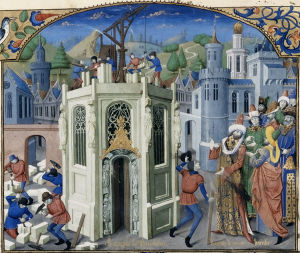
Axle
An axle is a central shaft for a rotating wheel or gear. On wheeled vehicles, the axle may be fixed to the wheels, rotating with them, or fixed to its surroundings, with the wheels rotating around the axle. In the former case, bearings or bushings are provided at the mounting points where the axle...
with a treadway wide enough for two workers walking side by side. While the earlier 'compass-arm' wheel had spokes directly driven into the central shaft, the more advanced 'clasp-arm' type featured arms arranged as chords to the wheel rim, giving the possibility of using a thinner shaft and providing thus a greater mechanical advantage.
Contrary to a popularly held belief, cranes on medieval building sites were neither placed on the extremely lightweight scaffolding
Scaffolding
Scaffolding is a temporary structure used to support people and material in the construction or repair of buildings and other large structures. It is usually a modular system of metal pipes or tubes, although it can be from other materials...
used at the time nor on the thin walls of the Gothic churches which were incapable of supporting the weight of both hoisting machine and load. Rather, cranes were placed in the initial stages of construction on the ground, often within the building. When a new floor was completed, and massive tie beams of the roof connected the walls, the crane was dismantled and reassembled on the roof beams from where it was moved from bay to bay during construction of the vaults. Thus, the crane 'grew' and 'wandered' with the building with the result that today all extant construction cranes in England are found in church towers above the vaulting and below the roof, where they remained after building construction for bringing material for repairs aloft.
Less frequently, medieval illuminations also show cranes mounted on the outside of walls with the stand of the machine secured to putlogs.
Mechanics and operation
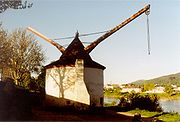
Pallet
A pallet , sometimes called a skid, is a flat transport structure that supports goods in a stable fashion while being lifted by a forklift, pallet jack, front loader or other jacking device. A pallet is the structural foundation of a unit load which allows handling and storage efficiencies...
s, basket
Basket
A basket is a container which is traditionally constructed from stiff fibres, which can be made from a range of materials, including wood splints, runners, and cane. While most baskets are made from plant materials, other materials such as horsehair, baleen, or metal wire can be used. Baskets are...
s, wooden boxes or barrel
Barrel
A barrel or cask is a hollow cylindrical container, traditionally made of vertical wooden staves and bound by wooden or metal hoops. Traditionally, the barrel was a standard size of measure referring to a set capacity or weight of a given commodity. A small barrel is called a keg.For example, a...
s.
It is noteworthy that medieval cranes rarely featured ratchets
Ratchet (device)
A ratchet is a device that allows continuous linear or rotary motion in only one direction while preventing motion in the opposite direction. Because most socket wrenches today use ratcheting handles, the term "ratchet" alone is often used to refer to a ratcheting wrench, and the terms "ratchet"...
or brake
Brake
A brake is a mechanical device which inhibits motion. Its opposite component is a clutch. The rest of this article is dedicated to various types of vehicular brakes....
s to forestall the load from running backward. This curious absence is explained by the high friction force
Friction
Friction is the force resisting the relative motion of solid surfaces, fluid layers, and/or material elements sliding against each other. There are several types of friction:...
exercised by medieval treadwheels which normally prevented the wheel from accelerating beyond control.
Harbour usage

See-Saw
See-Saw is a Japanese pop duo originally from Tokyo, Japan. Its members include Chiaki Ishikawa and Yuki Kajiura; former member left the group in April 1994 to pursue a writing career...
s, winch
Winch
A winch is a mechanical device that is used to pull in or let out or otherwise adjust the "tension" of a rope or wire rope . In its simplest form it consists of a spool and attached hand crank. In larger forms, winches stand at the heart of machines as diverse as tow trucks, steam shovels and...
es and yards
Yard (sailing)
A yard is a spar on a mast from which sails are set. It may be constructed of timber, steel, or from more modern materials, like aluminium or carbon fibre. Although some types of fore and aft rigs have yards , the term is usually used to describe the horizontal spars used with square sails...
.
Two different types of harbor cranes can be identified with a varying geographical distribution: While gantry cranes which pivoted on a central vertical axle were commonly found at the Flemish and Dutch coastside, German sea and inland harbors typically featured tower cranes where the windlass and treadwheels were situated in a solid tower with only jib arm and roof rotating. Interestingly, dockside cranes were not adopted in the Mediterranean region and the highly developed Italian ports where authorities continued to rely on the more labor-intensive method of unloading goods by ramps beyond the Middle Ages.
Unlike construction cranes where the work speed was determined by the relatively slow progress of the masons, harbor cranes usually featured double treadwheels to speed up loading. The two treadwheels whose diameter is estimated to be 4 m or larger were attached to each side of the axle and rotated together. Their capacity was 2–3 tons which apparently corresponded to the customary size of marine cargo. Today, according to one survey, fifteen treadwheel harbor cranes from pre-industrial times are still extant throughout Europe. Some harbour cranes were specialised at mounting masts to newly built sailing ships, such as in Danzig, Cologne
Cologne
Cologne is Germany's fourth-largest city , and is the largest city both in the Germany Federal State of North Rhine-Westphalia and within the Rhine-Ruhr Metropolitan Area, one of the major European metropolitan areas with more than ten million inhabitants.Cologne is located on both sides of the...
and Bremen
Bremen
The City Municipality of Bremen is a Hanseatic city in northwestern Germany. A commercial and industrial city with a major port on the river Weser, Bremen is part of the Bremen-Oldenburg metropolitan area . Bremen is the second most populous city in North Germany and tenth in Germany.Bremen is...
. Beside these stationary cranes, floating cranes
Crane vessel
A crane vessel, crane ship or floating crane is a ship with a crane specialized in lifting heavy loads. The largest crane vessels are used for offshore construction. Conventional monohulls are used, but the largest crane vessels are often catamaran or semi-submersible types as they have increased...
which could be flexibly deployed in the whole port basin came into use by the 14th century.
Renaissance
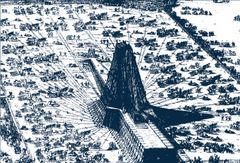
Renaissance architecture
Renaissance architecture is the architecture of the period between the early 15th and early 17th centuries in different regions of Europe, demonstrating a conscious revival and development of certain elements of ancient Greek and Roman thought and material culture. Stylistically, Renaissance...
Domenico Fontana
Domenico Fontana
Domenico Fontana was a Swiss-born Italian architect of the late Renaissance.-Biography:200px|thumb|Fountain of Moses in Rome....
in 1586 to relocate the 361 t heavy Vatican obelisk in Rome. From his report, it becomes obvious that the coordination of the lift between the various pulling teams required a considerable amount of concentration and discipline, since, if the force was not applied evenly, the excessive stress on the ropes would make them rupture.
Early modern age
Cranes were used domestically in the 17th and 18th century. The chimney or fireplace crane was used to swing pots and kettles over the fire and the height was adjusted by a trammelTrammel hook
A trammel hook is an adjustable hook used to suspend objects at variable heights.Trammel hooks may be used to hold a pot or kettle over a fire while cooking, allowing the height of the pot to be easily changed. Thus the rate of heating can be controlled....
.
Mechanical principles

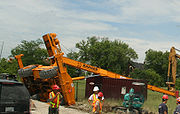
Lifting capacity
Cranes illustrate the use of one or more simple machineSimple machine
A simple machine is a mechanical device that changes the direction or magnitude of a force.In general, they can be defined as the simplest mechanisms that use mechanical advantage to multiply force. A simple machine uses a single applied force to do work against a single load force...
s to create mechanical advantage
Mechanical advantage
Mechanical advantage is a measure of the force amplification achieved by using a tool, mechanical device or machine system. Ideally, the device preserves the input power and simply trades off forces against movement to obtain a desired amplification in the output force...
.
- The leverLeverIn physics, a lever is a rigid object that is used with an appropriate fulcrum or pivot point to either multiply the mechanical force that can be applied to another object or resistance force , or multiply the distance and speed at which the opposite end of the rigid object travels.This leverage...
. A balance crane contains a horizontal beam (the lever) pivoted about a point called the fulcrumLeverIn physics, a lever is a rigid object that is used with an appropriate fulcrum or pivot point to either multiply the mechanical force that can be applied to another object or resistance force , or multiply the distance and speed at which the opposite end of the rigid object travels.This leverage...
. The principle of the lever allows a heavy load attached to the shorter end of the beam to be lifted by a smaller forceForceIn physics, a force is any influence that causes an object to undergo a change in speed, a change in direction, or a change in shape. In other words, a force is that which can cause an object with mass to change its velocity , i.e., to accelerate, or which can cause a flexible object to deform...
applied in the opposite direction to the longer end of the beam. The ratio of the load's weight to the applied force is equal to the ratio of the lengths of the longer arm and the shorter arm, and is called the mechanical advantageMechanical advantageMechanical advantage is a measure of the force amplification achieved by using a tool, mechanical device or machine system. Ideally, the device preserves the input power and simply trades off forces against movement to obtain a desired amplification in the output force...
. - The pulleyPulleyA pulley, also called a sheave or a drum, is a mechanism composed of a wheel on an axle or shaft that may have a groove between two flanges around its circumference. A rope, cable, belt, or chain usually runs over the wheel and inside the groove, if present...
. A jib crane contains a tilted strut (the jib) that supports a fixed pulley block. Cables are wrapped multiple times round the fixed block and round another block attached to the load. When the free end of the cable is pulled by hand or by a winding machine, the pulley system delivers a force to the load that is equal to the applied force multiplied by the number of lengths of cable passing between the two blocks. This number is the mechanical advantage. - The hydraulic cylinderHydraulicsHydraulics is a topic in applied science and engineering dealing with the mechanical properties of liquids. Fluid mechanics provides the theoretical foundation for hydraulics, which focuses on the engineering uses of fluid properties. In fluid power, hydraulics is used for the generation, control,...
. This can be used directly to lift the load or indirectly to move the jib or beam that carries another lifting device.
Cranes, like all machines, obey the principle of conservation of energy
Conservation of energy
The nineteenth century law of conservation of energy is a law of physics. It states that the total amount of energy in an isolated system remains constant over time. The total energy is said to be conserved over time...
. This means that the energy
Energy
In physics, energy is an indirectly observed quantity. It is often understood as the ability a physical system has to do work on other physical systems...
delivered to the load cannot exceed the energy put into the machine. For example, if a pulley system multiplies the applied force by ten, then the load moves only one tenth as far as the applied force. Since energy is proportional to force multiplied by distance, the output energy is kept roughly equal to the input energy (in practice slightly less, because some energy is lost to friction
Friction
Friction is the force resisting the relative motion of solid surfaces, fluid layers, and/or material elements sliding against each other. There are several types of friction:...
and other inefficiencies).
The same principle can operate in reverse. In case of some problem, the combination of heavy load and great height can accelerate small objects to tremendous speed (see trebuchet
Trebuchet
A trebuchet is a siege engine that was employed in the Middle Ages. It is sometimes called a "counterweight trebuchet" or "counterpoise trebuchet" in order to distinguish it from an earlier weapon that has come to be called the "traction trebuchet", the original version with pulling men instead of...
). Such projectiles can result in severe damage to nearby structures and people. Cranes can also get in chain reactions; the rupture of one crane may in turn take out nearby cranes. Cranes need to be watched carefully.
Stability
For stability, the sum of all momentsMoment (physics)
In physics, the term moment can refer to many different concepts:*Moment of force is the tendency of a force to twist or rotate an object; see the article torque for details. This is an important, basic concept in engineering and physics. A moment is valued mathematically as the product of the...
about any point such as the base of the crane must equate to zero. In practice, the magnitude of load that is permitted to be lifted (called the "rated load" in the US) is some value less than the load that will cause the crane to tip (providing a safety margin).
Under US standards for mobile cranes, the stability-limited rated load for a crawler crane is 75% of the tipping load. The stability-limited rated load for a mobile crane supported on outriggers is 85% of the tipping load. These requirements, along with additional safety-related aspects of crane design, are established by the American Society of Mechanical Engineers http://www.asme.org in the volume ASME B30.5-2007 Mobile and Locomotive Cranes.
Standards for cranes mounted on ships or offshore platforms are somewhat stricter because of the dynamic load on the crane due to vessel motion. Additionally, the stability of the vessel or platform must be considered.
For stationary pedestal or kingpost mounted cranes, the moment created by the boom, jib, and load is resisted by the pedestal base or kingpost. Stress within the base must be less than the yield stress of the material or the crane will fail.
Overhead crane
An overhead craneOverhead crane
An overhead crane, commonly called a bridge crane, is a type of crane found in industrial environments. An overhead crane consists of parallel runways with a traveling bridge spanning the gap...
, also known as a bridge crane, is a type of crane where the hook-and-line mechanism runs along a horizontal beam that itself runs along two widely separated rails. Often it is in a long factory building and runs along rails along the building's two long walls. It is similar to a gantry crane
Gantry crane
Gantry cranes, bridge cranes, and overhead cranes, are all types of cranes which lift objects by a hoist which is fitted in a hoist trolley and can move horizontally on a rail or pair of rails fitted under a beam...
. Overhead cranes typically consist of either a single beam or a double beam construction. These can be built using typical steel beams or a more complex box girder type. Pictured on the right is a single bridge box girder crane with the hoist
Hoist (device)
A hoist is a device used for lifting or lowering a load by means of a drum or lift-wheel around which rope or chain wraps. It may be manually operated, electrically or pneumatically driven and may use chain, fiber or wire rope as its lifting medium. The load is attached to the hoist by means of a...
and system operated with a control pendant. Double girder bridge are more typical when needing heavier capacity systems from 10 tons and above. The advantage of the box girder type configuration results in a system that has a lower deadweight yet a stronger overall system integrity. Also included would be a hoist to lift the items, the bridge, which spans the area covered by the crane, and a trolley to move along the bridge.
The most common overhead crane use is in the steel industry. At every step of the manufacturing process, until it leaves a factory as a finished product, steel
Steel
Steel is an alloy that consists mostly of iron and has a carbon content between 0.2% and 2.1% by weight, depending on the grade. Carbon is the most common alloying material for iron, but various other alloying elements are used, such as manganese, chromium, vanadium, and tungsten...
is handled by an overhead crane. Raw materials are poured into a furnace
Furnace
A furnace is a device used for heating. The name derives from Latin fornax, oven.In American English and Canadian English, the term furnace on its own is generally used to describe household heating systems based on a central furnace , and sometimes as a synonym for kiln, a device used in the...
by crane, hot steel is stored for cooling by an overhead crane, the finished coil
Coil
A coil is a series of loops. A coiled coil is a structure in which the coil itself is in turn also looping.-Electromagnetic coils:An electromagnetic coil is formed when a conductor is wound around a core or form to create an inductor or electromagnet...
s are lifted and loaded onto truck
Truck
A truck or lorry is a motor vehicle designed to transport cargo. Trucks vary greatly in size, power, and configuration, with the smallest being mechanically similar to an automobile...
s and train
Train
A train is a connected series of vehicles for rail transport that move along a track to transport cargo or passengers from one place to another place. The track usually consists of two rails, but might also be a monorail or maglev guideway.Propulsion for the train is provided by a separate...
s by overhead crane, and the fabricator
Fabrication (metal)
Fabrication as an industrial term refers to building metal structures by cutting, bending, and assembling. The cutting part of fabrication is via sawing, shearing, or chiseling ; torching with handheld torches ; and via CNC cutters...
or stamper uses an overhead crane to handle the steel in his factory. The automobile
Automobile
An automobile, autocar, motor car or car is a wheeled motor vehicle used for transporting passengers, which also carries its own engine or motor...
industry uses overhead cranes for handling of raw materials. Smaller workstation
Workstation
A workstation is a high-end microcomputer designed for technical or scientific applications. Intended primarily to be used by one person at a time, they are commonly connected to a local area network and run multi-user operating systems...
cranes handle lighter loads in a work-area, such as CNC mill or saw.
Almost all paper mills use bridge cranes for regular maintenance requiring removal of heavy press rolls and other equipment. The bridge cranes are used in the initial construction of paper machines because they facilitate installation of the heavy cast iron paper drying drums and other massive equipment, some weighing as much as 70 tons.
In many instances the cost of a bridge crane can be largely offset with savings from not renting mobile cranes in the construction of a facility that uses a lot of heavy process equipment.
Mobile
The most basic type of mobile crane consists of a trussTruss
In architecture and structural engineering, a truss is a structure comprising one or more triangular units constructed with straight members whose ends are connected at joints referred to as nodes. External forces and reactions to those forces are considered to act only at the nodes and result in...
or telescopic boom mounted on a mobile platform - be it on road, rail or water. Common terminology is conventional and hydraulic cranes respectively.
Truck-mounted crane

Truck
A truck or lorry is a motor vehicle designed to transport cargo. Trucks vary greatly in size, power, and configuration, with the smallest being mechanically similar to an automobile...
carrier provides the mobility for this type of crane. This crane has two parts: the carrier, often referred to as the Lower, and the lifting component which includes the boom, referred to as the Upper. These are mated together through a turntable allowing the upper to swing from side to side. These modern hydraulic truck cranes are usually single-engine machines, with the same engine powering the undercarriage and the crane. the upper is usually powered via hydraulics run through the turntable from the pump mounted on the lower. In older model designs of hydraulic truck cranes there were 2 engines. One in the lower pulled the crane down the road and ran a hydraulic pump for the outriggers and jacks. The one in the upper ran the upper through a hydraulic pump of its own. Many older operaters favor the 2 engine system due to leaking seals in the turntable of aging newer design cranes.
Generally, these cranes are able to travel on highways, eliminating the need for special equipment to transport the crane unless weight or other size constrictions are in place such as local laws. If this is the case most larger cranes are equipped with either special trailers to help spread the load over more axles or are able to disassemble to meet requirements. An example is counterweights. Often a crane will be followed by another truck hauling the counterweights that are removed for travel. In addition some cranes are able to remove the entire upper. However, this is usually only an issue in a large crane and mostly done with a conventional crane such as a link-belt HC-238. When working on the jobsite, outrigger
Outrigger
An outrigger is a part of a boat's rigging which is rigid and extends beyond the side or gunwale of a boat.In an outrigger canoe and in sailboats such as the proa, an outrigger is a thin, long, solid, hull used to stabilise an inherently unstable main hull. The outrigger is positioned rigidly and...
s are extended horizontally from the chassis then vertically to level and stabilize the crane while stationary and hoisting
Hoist (device)
A hoist is a device used for lifting or lowering a load by means of a drum or lift-wheel around which rope or chain wraps. It may be manually operated, electrically or pneumatically driven and may use chain, fiber or wire rope as its lifting medium. The load is attached to the hoist by means of a...
. Many truck cranes have slow-travelling capability (a few miles per hour) while suspending a load. Great care must be taken not to swing the load sideways from the direction of travel, as most anti-tipping stability then lies in the stiffness of the chassis suspension. Most cranes of this type also have moving counterweights for stabilization beyond that provided by the outriggers. Loads suspended directly aft are the most stable, since most of the weight of the crane acts as a counterweight. Factory-calculated charts (or electronic safeguards) are used by crane operators to determine the maximum safe loads for stationary (outriggered) work as well as (on-rubber) loads and travelling speeds.
Truck cranes range in lifting capacity from about 14.5 ST (12.9 LT; 13.2 t) to about 1300 ST (1,161 LT; 1,179 t).
Sidelift crane

Truck
A truck or lorry is a motor vehicle designed to transport cargo. Trucks vary greatly in size, power, and configuration, with the smallest being mechanically similar to an automobile...
or semi-trailer
Semi-trailer
A semi-trailer is a trailer without a front axle. A large proportion of its weight is supported by a road tractor, a detachable front axle assembly known as a dolly, or the tail of another trailer...
, able to hoist and transport ISO standard containers
Intermodal container
An intermodal container is a standardized reusable steel box used for the safe, efficient and secure storage and movement of materials and products within a global containerized intermodal freight transport system...
. Container lift is done with parallel crane-like hoists, which can lift a container from the ground or from a railway vehicle
Flatcar
A flatcar is a piece of railroad or railway rolling stock that consists of an open, flat deck on four or six wheels or a pair of trucks or bogies . The deck of the car can be wood or steel, and the sides of the deck can include pockets for stakes or tie-down points to secure loads...
.
Rough terrain crane

These telescopic cranes are single-engine machines, with the same engine powering the undercarriage and the crane, similar to a crawler crane. In a rough terrain crane, the engine is usually mounted in the undercarriage rather than in the upper, as with crawler crane. Most have 4 wheel drive and 4 wheel steering which allows them to traverse tighter and slicker terrain than a standard truck crane with less site prep. In addition, there are rough terrain cranes with the operating cab mounted on the lower as opposed to the P&H in the above image.
All terrain crane
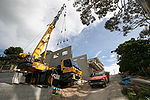
AT’s have 2-9 axles and are designed for lifting loads up to 1200 t (1,323 ST; 1,181 LT).
Pick and carry crane
A Pick and Carry Crane is similar to a mobile crane in that is designed to travel on public roads, however Pick and Carry cranes have no stabiliser legs or outriggers and are designed to lift the load and carry it to its destination, within a small radius, then be able to drive to the next job. Pick and Carry cranes are popular in Australia where large distances are encountered between job sites. One popular manufacturer in Australia was Franna, who have since been bought by Terex, and now all pick and carry cranes are commonly referred to as "Frannas" even though they may be made by other manufacturers . Nearly every medium and large sized crane company in Australia has at least one and many companies have fleets of these cranes. The capacity range is usually ten to twenty tonnes maximum lift, although this is much less at the tip of the boom. Pick and Carry cranes have displaced the work usually completed by smaller truck cranes as the set up time is much quicker. Many steel fabrication yards also use pick and carry cranes as they can "walk" with fabricated steel sections and place these where required with relative ease.Carry deck crane
A carry deck crane is a small 4 wheel crane with a 360 degree rotating boom placed right in the centre and an operators cab located at one end under this boom. The rear section houses the engine and the area above the wheels is a flat deck. Very Much an American invention the Carry deck can hoist a load in a confined space and then load it on the deck space around the cab or engine and subsequently move to another site. The Carry Deck principle is the American version of the pick and carry crane and both allow the load to be moved by the crane over short distances.Telescopic handler crane
Telescopic Handlers are like forklift trucks that have a telescoping extendable boom like a crane. Early telescopic handlers only lifted in one direction and did not rotate, however, several of the manufacturers have designed telescopic handlers that rotate 360 degrees through a turntable and these machines look almost identical to the Rough Terrain Crane. These new 360 degree telescopic handler/crane models have outriggers or stabiliser legs that must be lowered before lifting, however their design has been simplified so that they can be more quickly deployed. These machines are often used to handle pallets of bricks and install frame trusses on many new building sites and they have eroded much of the work for small telescopic truck cranes. Many of the worlds Armed forces have purchased telescopic handlers and some of these are the much more expensive fully rotating types. Their off road capability and their on site versatility to unload pallets using forks, or lift like a crane makes them a valuable piece of machinery.Crawler crane
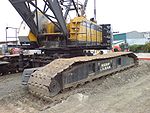
Crawler cranes have both advantages and disadvantages depending on their use. Their main advantage is that they can move around on site and perform each lift with little set-up, since the crane is stable on its tracks with no outriggers. In addition, a crawler crane is capable of traveling with a load. The main disadvantage is that they are very heavy, and cannot easily be moved from one job site to another without significant expense. Typically a large crawler must be disassembled and moved by trucks, rail cars or ships to its next location.
Railroad crane
A railroad craneCrane (railroad)
A railroad crane, is a type of crane used on a railroad for one of three primary uses: freight handling in goods yards, permanent way maintenance, and accident recovery work...
has flanged wheels for use on railroads. The simplest form is a crane mounted on a flatcar
Flatcar
A flatcar is a piece of railroad or railway rolling stock that consists of an open, flat deck on four or six wheels or a pair of trucks or bogies . The deck of the car can be wood or steel, and the sides of the deck can include pockets for stakes or tie-down points to secure loads...
. More capable devices are purpose-built.
Different types of crane are used for maintenance work, recovery operations and freight loading in goods yards.
Floating crane
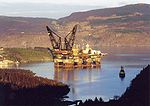
Crane vessel
A crane vessel, crane ship or floating crane is a ship with a crane specialized in lifting heavy loads. The largest crane vessels are used for offshore construction. Conventional monohulls are used, but the largest crane vessels are often catamaran or semi-submersible types as they have increased...
s are used mainly in bridge
Bridge
A bridge is a structure built to span physical obstacles such as a body of water, valley, or road, for the purpose of providing passage over the obstacle...
building and port
Port
A port is a location on a coast or shore containing one or more harbors where ships can dock and transfer people or cargo to or from land....
construction, but they are also used for occasional loading and unloading of especially heavy or awkward loads on and off ships. Some floating cranes are mounted on a pontoon
Pontoon (boat)
A pontoon is a flotation device with buoyancy sufficient to float itself as well as a heavy load. A pontoon boat is a flattish boat that relies on pontoons to float. Pontoons may be used on boats, rafts, barges, docks, floatplanes or seaplanes. Pontoons may support a platform, creating a raft. A...
, others are specialized crane barge
Barge
A barge is a flat-bottomed boat, built mainly for river and canal transport of heavy goods. Some barges are not self-propelled and need to be towed by tugboats or pushed by towboats...
s with a lifting capacity exceeding 10000 ST (8,929 LT; 9,072 t) and have been used to transport entire bridge sections. Floating cranes have also been used to salvage sunken ship
Ship
Since the end of the age of sail a ship has been any large buoyant marine vessel. Ships are generally distinguished from boats based on size and cargo or passenger capacity. Ships are used on lakes, seas, and rivers for a variety of activities, such as the transport of people or goods, fishing,...
s.
Crane vessel
Crane vessel
A crane vessel, crane ship or floating crane is a ship with a crane specialized in lifting heavy loads. The largest crane vessels are used for offshore construction. Conventional monohulls are used, but the largest crane vessels are often catamaran or semi-submersible types as they have increased...
s are often used in offshore construction
Offshore construction
Offshore construction is the installation of structures and facilities in a marine environment, usually for the production and transmission of electricity, oil, gas and other resources....
. The largest revolving cranes can be found on SSCV Thialf
SSCV Thialf
SSCV Thialf is a semi-submersible crane vessel operated by Heerema Marine Contractors, the largest crane vessel in the world.-History:SSCV Thialf was constructed in 1985 as DB-102 for McDermott by Mitsui Engineering & Shipbuilding Co., Ltd...
, which has two cranes with a capacity of 7100 t (7,826 ST; 6,988 LT) each. For fifty years, the largest such crane was "Herman the German" at the Long Beach Naval Shipyard, one of three constructed by Hitler's Germany and captured in the war. The crane was sold to the Panama Canal in 1996 where it is now known as the "Titan."
Aerial crane
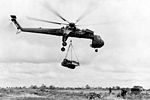
Aerial crane
Helicopters used to lift heavy loads are called aerial cranes or skycranes. As aerial cranes, helicopters carry loads connected to long cables or slings in order to place heavy equipment when other methods are not available or economically feasible, or when the job must be accomplished in remote or...
or 'Sky cranes' usually are helicopter
Helicopter
A helicopter is a type of rotorcraft in which lift and thrust are supplied by one or more engine-driven rotors. This allows the helicopter to take off and land vertically, to hover, and to fly forwards, backwards, and laterally...
s designed to lift large loads. Helicopters are able to travel to and lift in areas that are difficult to reach by conventional cranes. Helicopter cranes are most commonly used to lift units/loads onto shopping centers and highrises. They can lift anything within their lifting capacity, (cars, boats, swimming pools, etc.). They also perform disaster relief after natural disasters for clean-up, and during wild-fires they are able to carry huge buckets of water to extinguish fires.
Some aerial cranes, mostly concepts, have also used lighter-than air aircraft, such as airship
Airship
An airship or dirigible is a type of aerostat or "lighter-than-air aircraft" that can be steered and propelled through the air using rudders and propellers or other thrust mechanisms...
s.
Fixed
Exchanging mobility for the ability to carry greater loads and reach greater heights due to increased stability, these types of cranes are characterised by the fact that their main structure does not move during the period of use. However, many can still be assembled and disassembled.Tower crane
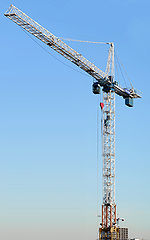
The long horizontal jib is the part of the crane that carries the load. The counter-jib carries a counterweight, usually of concrete blocks, while the jib suspends the load to and from the center of the crane. The crane operator either sits in a cab at the top of the tower or controls the crane by radio remote control from the ground. In the first case the operator's cab is most usually located at the top of the tower attached to the turntable, but can be mounted on the jib, or partway down the tower. The lifting hook is operated by the crane operator using electric motors to manipulate wire rope cables through a system of sheaves. The hook is located on the long horizontal arm to lift the load which also contains its motor.
In order to hook and unhook the loads, the operator usually works in conjunction with a signaller (known as a 'dogger', 'rigger' or 'swamper'). They are most often in radio contact, and always use hand signals. The rigger or dogger directs the schedule of lifts for the crane, and is responsible for the safety of the rigging and loads.
A tower crane is usually assembled by a telescopic jib (mobile) crane of greater reach (also see "self-erecting crane" below) and in the case of tower cranes that have risen while constructing very tall skyscrapers, a smaller crane (or derrick) will often be lifted to the roof of the completed tower to dismantle the tower crane afterwards, which may be more difficult than the installation.
Self-erecting crane
Generally a type of tower crane, these cranes, also called self-assembling, jack-up crane or "Kangaroo" cranes, lift themselves from the ground or lift an upper, telescoping section using jacks, allowing the next section of the tower to be inserted at ground level or lifted into place by the partially erected crane itself. They can thus be assembled without outside help, and can grow together with the building or structure they are erecting.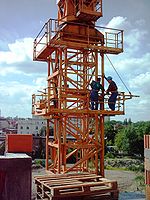
Telescopic crane
A telescopic crane has a boom that consists of a number of tubes fitted one inside the other. A hydraulicHydraulics
Hydraulics is a topic in applied science and engineering dealing with the mechanical properties of liquids. Fluid mechanics provides the theoretical foundation for hydraulics, which focuses on the engineering uses of fluid properties. In fluid power, hydraulics is used for the generation, control,...
or other powered mechanism extends or retracts the tubes to increase or decrease the total length of the boom. These types of booms are often used for short term construction projects, rescue jobs, lifting boats in and out of the water, etc. The relative compactness of telescopic booms make them adaptable for many mobile applications.
Note that while telescopic cranes are not automatically mobile cranes, many of them are often truck-mounted.
Hammerhead crane

Cantilever
A cantilever is a beam anchored at only one end. The beam carries the load to the support where it is resisted by moment and shear stress. Cantilever construction allows for overhanging structures without external bracing. Cantilevers can also be constructed with trusses or slabs.This is in...
, crane is a fixed-jib
Jib
A jib is a triangular staysail set ahead of the foremast of a sailing vessel. Its tack is fixed to the bowsprit, to the bow, or to the deck between the bowsprit and the foremost mast...
crane consisting of a steel-braced tower on which revolves a large, horizontal, double cantilever
Cantilever
A cantilever is a beam anchored at only one end. The beam carries the load to the support where it is resisted by moment and shear stress. Cantilever construction allows for overhanging structures without external bracing. Cantilevers can also be constructed with trusses or slabs.This is in...
; the forward part of this cantilever or jib
Jib
A jib is a triangular staysail set ahead of the foremast of a sailing vessel. Its tack is fixed to the bowsprit, to the bow, or to the deck between the bowsprit and the foremost mast...
carries the lifting trolley, the jib is extended backwards in order to form a support for the machinery and counter-balancing weight. In addition to the motions of lifting and revolving, there is provided a so-called "racking" motion, by which the lifting trolley, with the load suspended, can be moved in and out along the jib without altering the level of the load. Such horizontal movement of the load is a marked feature of later crane design. These cranes are generally constructed in large sizes, up to 350 tons.
The design of hammerkran evolved first in Germany around the turn of the 19th century and was adopted and developed for use in British
United Kingdom
The United Kingdom of Great Britain and Northern IrelandIn the United Kingdom and Dependencies, other languages have been officially recognised as legitimate autochthonous languages under the European Charter for Regional or Minority Languages...
shipyard
Shipyard
Shipyards and dockyards are places which repair and build ships. These can be yachts, military vessels, cruise liners or other cargo or passenger ships. Dockyards are sometimes more associated with maintenance and basing activities than shipyards, which are sometimes associated more with initial...
s to support the battleship construction program from 1904 to 1914. The ability of the hammerhead crane to lift heavy weights was useful for installing large pieces of battleship
Battleship
A battleship is a large armored warship with a main battery consisting of heavy caliber guns. Battleships were larger, better armed and armored than cruisers and destroyers. As the largest armed ships in a fleet, battleships were used to attain command of the sea and represented the apex of a...
s such as armour plate and gun
Gun
A gun is a muzzle or breech-loaded projectile-firing weapon. There are various definitions depending on the nation and branch of service. A "gun" may be distinguished from other firearms in being a crew-served weapon such as a howitzer or mortar, as opposed to a small arm like a rifle or pistol,...
barrels. Giant cantilever cranes were also installed in naval shipyards in Japan
Japan
Japan is an island nation in East Asia. Located in the Pacific Ocean, it lies to the east of the Sea of Japan, China, North Korea, South Korea and Russia, stretching from the Sea of Okhotsk in the north to the East China Sea and Taiwan in the south...
and in the US
United States
The United States of America is a federal constitutional republic comprising fifty states and a federal district...
. The British Government also installed a giant cantilever crane at the Singapore
Singapore
Singapore , officially the Republic of Singapore, is a Southeast Asian city-state off the southern tip of the Malay Peninsula, north of the equator. An island country made up of 63 islands, it is separated from Malaysia by the Straits of Johor to its north and from Indonesia's Riau Islands by the...
Naval Base (1938) and later a copy of the crane was installed at Garden Island Naval Dockyard in Sydney
Sydney
Sydney is the most populous city in Australia and the state capital of New South Wales. Sydney is located on Australia's south-east coast of the Tasman Sea. As of June 2010, the greater metropolitan area had an approximate population of 4.6 million people...
(1951). These cranes provided repair support for the battle fleet operating far from Great Britain
Great Britain
Great Britain or Britain is an island situated to the northwest of Continental Europe. It is the ninth largest island in the world, and the largest European island, as well as the largest of the British Isles...
.
The principal engineering firm for giant cantilever cranes in the British Empire was Sir William Arrol & Co Ltd building 14. Of around 60 built across the world few remain; 7 in England and Scotland of about 15 worldwide.
The Titan Clydebank
Titan Clydebank
Titan Clydebank is a high cantilever crane that was built in 1907 in Clydebank, Scotland. It was designed to be used in the lifting of heavy equipment, such as engines and boilers, during the fitting-out of battleships and ocean liners at the John Brown & Company shipyard, then the biggest...
is one of the 4 Scottish cranes on the Clydebank and preserved as a tourist attraction.
Level luffing crane
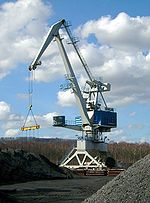
Luff
Luff or luffing may refer to:* Luffing, when a sailing sheet is eased so far past trim that airflow over the surface is disrupted* The leading edge of a sail...
s). A level luffing crane
Level luffing crane
A level-luffing crane is a crane mechanism where the hook remains at the same level whilst luffing; moving the jib up and down, so as to move the hook inwards and outwards relative to the base....
is a crane of this common design, but with an extra mechanism to keep the hook level when luffing.
Gantry crane

Gantry crane
Gantry cranes, bridge cranes, and overhead cranes, are all types of cranes which lift objects by a hoist which is fitted in a hoist trolley and can move horizontally on a rail or pair of rails fitted under a beam...
has a hoist
Hoist (device)
A hoist is a device used for lifting or lowering a load by means of a drum or lift-wheel around which rope or chain wraps. It may be manually operated, electrically or pneumatically driven and may use chain, fiber or wire rope as its lifting medium. The load is attached to the hoist by means of a...
in a fixed machinery house or on a trolley that runs horizontally along rails, usually fitted on a single beam (mono-girder) or two beams (twin-girder). The crane frame is supported on a gantry system with equalized beams and wheels that run on the gantry rail, usually perpendicular to the trolley travel direction. These cranes come in all sizes, and some can move very heavy loads, particularly the extremely large examples used in shipyards or industrial installations. A special version is the container crane (or "Portainer" crane, named by the first manufacturer), designed for loading and unloading ship-borne containers at a port.
Most container cranes are of this type.
Deck crane
.jpg)
Jib crane
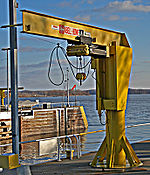
Bulk-handling crane
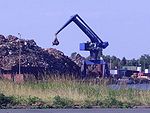
Bulk-handling crane
A bulk-handling crane is one that, instead of a simple hook that can handle a range of slung loads, has an integral grab for lifting bulk cargoes such as coal, mineral ore etc....
s are designed from the outset to carry a shell grab or bucket, rather than using a hook and a sling. They are used for bulk cargoes, such as coal, minerals, scrap metal etc.
Loader crane

Truck
A truck or lorry is a motor vehicle designed to transport cargo. Trucks vary greatly in size, power, and configuration, with the smallest being mechanically similar to an automobile...
or trailer
Trailer (vehicle)
A trailer is generally an unpowered vehicle pulled by a powered vehicle. Commonly, the term trailer refers to such vehicles used for transport of goods and materials....
, and is used for loading/unloading the vehicle. The numerous jointed sections can be folded into a small space when the crane is not in use. One or more of the sections may be telescopic
Telescopic cylinder
Telescopic cylinders are a special design of hydraulic cylinder that provide an exceptionally long output travel from a very compact retracted length. Typically the collapsed length of a telescopic cylinder is 20 to 40%...
. Often the crane will have a degree of automation and be able to unload or stow itself without an operator's instruction.
Unlike most cranes, the operator must move around the vehicle to be able to view his load; hence modern cranes may be fitted with a portable cabled or radio-linked control system to supplement the crane-mounted hydraulic control levers.
In the UK and Canada, this type of crane is often known colloquially as a "Hiab", partly because this manufacturer invented the loader crane and was first into the UK market, and partly because the distinctive name was displayed prominently on the boom arm.
A rolloader crane is a loader crane mounted on a chassis with wheels. This chassis can ride on the trailer. Because the crane can move on the trailer, it can be a light crane, so the trailer is allowed to transport more goods.
Stacker crane
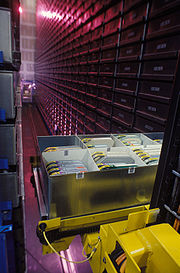
Warehouse
A warehouse is a commercial building for storage of goods. Warehouses are used by manufacturers, importers, exporters, wholesalers, transport businesses, customs, etc. They are usually large plain buildings in industrial areas of cities and towns. They usually have loading docks to load and unload...
s (known as an automated storage and retrieval system
Automated Storage and Retrieval System
An automated storage and retrieval system consists of a variety of computer-controlled methods for automatically placing and retrieving loads from specific storage locations...
(AS/RS)). The crane moves on a track in an aisle of the warehouse. The fork can be raised or lowered to any of the levels of a storage rack and can be extended into the rack to store and retrieve product. The product can in some cases be as large as an automobile
Automobile
An automobile, autocar, motor car or car is a wheeled motor vehicle used for transporting passengers, which also carries its own engine or motor...
. Stacker cranes are often used in the large freezer warehouses of frozen food manufacturers. This automation avoids requiring forklift drivers to work in below freezing temperatures every day.
Similar machines
The generally-accepted definition of a crane is a machine for lifting and moving heavy objects by means of ropes or cables suspended from a movable arm. As such, a lifting machine that does not use cables, or else provides only vertical and not horizontal movement, cannot strictly be called a 'crane'.Types of crane-like lifting machine include:
- Block and tackleBlock and tackleA block and tackle is a system of two or more pulleys with a rope or cable threaded between them, usually used to lift or pull heavy loads.The pulleys are assembled together to form blocks so that one is fixed and one moves with the load...
- Capstan (nautical)Capstan (nautical)A capstan is a vertical-axled rotating machine developed for use on sailing ships to apply force to ropes, cables, and hawsers. The principle is similar to that of the windlass, which has a horizontal axle.- History :...
- Hoist (device)Hoist (device)A hoist is a device used for lifting or lowering a load by means of a drum or lift-wheel around which rope or chain wraps. It may be manually operated, electrically or pneumatically driven and may use chain, fiber or wire rope as its lifting medium. The load is attached to the hoist by means of a...
- WinchWinchA winch is a mechanical device that is used to pull in or let out or otherwise adjust the "tension" of a rope or wire rope . In its simplest form it consists of a spool and attached hand crank. In larger forms, winches stand at the heart of machines as diverse as tow trucks, steam shovels and...
- WindlassWindlassThe windlass is an apparatus for moving heavy weights. Typically, a windlass consists of a horizontal cylinder , which is rotated by the turn of a crank or belt...
- Cherry PickerCherry pickerA cherry picker , is a type of aerial work platform that consists of a platform or bucket at the end of a hydraulic lifting system.- Design :...
More technically-advanced types of such lifting machines are often known as 'cranes', regardless of the official definition of the term.
Special examples
- Finnieston CraneFinnieston CraneThe Finnieston Crane is a crane and landmark in Glasgow, Scotland. It is now disused but is retained as a symbol of the city's engineering heritage.- History :...
(aka the Stobcross Crane)- – Category A -listed example of a 'hammerhead' (cantilever) crane in GlasgowGlasgowGlasgow is the largest city in Scotland and third most populous in the United Kingdom. The city is situated on the River Clyde in the country's west central lowlands...
's former docks - – 50 m (164 ft) tall, 175 tonnes (172.2 LT) capacity, built 1926
- – Category A -listed example of a 'hammerhead' (cantilever) crane in Glasgow
- TaisunTaisunTaisun is the world's strongest crane and has a safe working load of 20,000 metric tons . Taisun is designed and built for the installation of very large modules in semi submersibles and FPSO projects and located at Yantai Raffles Shipyard in Yantai, Shandong Province, China...
- – double bridge crane at YantaiYantaiYantai is a prefecture-level city in northeastern Shandong province, People's Republic of China. Located on the southern coast of the Bohai Sea and the eastern coast of the Laizhou Bay, Yantai borders the cities of Qingdao and Weihai to the southwest and east respectively.The largest fishing...
, ChinaChinaChinese civilization may refer to:* China for more general discussion of the country.* Chinese culture* Greater China, the transnational community of ethnic Chinese.* History of China* Sinosphere, the area historically affected by Chinese culture...
. - – 20000 t (22,046 ST; 19,684 LT) capacity, World Record Holder
- – 133 m (436 ft) tall, 120 m (394 ft) span, lift-height 80 m (262 ft)
- – double bridge crane at Yantai
- Kockums Crane
- – shipyard crane formerly at KockumsKockumsKockums AB is a shipyard in Malmö, Sweden owned by the German shipyard Howaldtswerke-Deutsche Werft in Kiel. HDW itself is a subsidiary of the German ThyssenKrupp Marine Systems....
, SwedenSwedenSweden , officially the Kingdom of Sweden , is a Nordic country on the Scandinavian Peninsula in Northern Europe. Sweden borders with Norway and Finland and is connected to Denmark by a bridge-tunnel across the Öresund....
. - – 138 m (453 ft) tall, 1500 tonnes (1,476.3 LT) capacity, since moved to UlsanUlsanUlsan , officially the Ulsan Metropolitan City, is South Korea's seventh largest metropolis with a population of over 1.1 million. It is located in the south-east of the country, neighboring Busan to the south and facing Gyeongju to the north and the Sea of Japan to the east.Ulsan is the...
, South KoreaSouth KoreaThe Republic of Korea , , is a sovereign state in East Asia, located on the southern portion of the Korean Peninsula. It is neighbored by the People's Republic of China to the west, Japan to the east, North Korea to the north, and the East China Sea and Republic of China to the south...
- – shipyard crane formerly at Kockums
- Samson and Goliath (cranes)Samson and Goliath (cranes)Samson and Goliath are the twin shipbuilding gantry cranes situated at Queen's Island, Belfast, Northern Ireland. The cranes, which were named after the Biblical figures Samson and Goliath, dominate the Belfast skyline and are landmark structures of the city....
- – two gantry craneGantry craneGantry cranes, bridge cranes, and overhead cranes, are all types of cranes which lift objects by a hoist which is fitted in a hoist trolley and can move horizontally on a rail or pair of rails fitted under a beam...
s at the Harland & Wolff shipyard in BelfastBelfastBelfast is the capital of and largest city in Northern Ireland. By population, it is the 14th biggest city in the United Kingdom and second biggest on the island of Ireland . It is the seat of the devolved government and legislative Northern Ireland Assembly... - – Goliath is 96 m (315 ft) tall, Samson is 106 m (348 ft)
- – span 140 m (459 ft), lift-height 70 m (230 ft), capacity 840 tonnes (826.7 LT) each, 1600 tonnes (1,574.7 LT) combined
- – two gantry crane
- Breakwater Crane RailwayBreakwater Crane RailwayThe Douglas Breakwater Crane Railway was a massive self-propelled steam crane that ran the length of the original breakwater at Douglas, for the loading and unloading of vessels. The crane was owned by the Isle of Man Harbour Board and ran on gauge track, the broadest in the British Isles. It was...
- – self-propelled steam crane that formerly ran the length of the breakwater at DouglasDouglas, Isle of Manright|thumb|250px|Douglas Promenade, which runs nearly the entire length of beachfront in Douglasright|thumb|250px|Sea terminal in DouglasDouglas is the capital and largest town of the Isle of Man, with a population of 26,218 people . It is located at the mouth of the River Douglas, and a sweeping...
. - – ran on 10 feet (3.05 m) gauge track, the broadest in the British Isles
- – self-propelled steam crane that formerly ran the length of the breakwater at Douglas
Crane manufactures
- American (USA) Crawler -- Now part of Terex
- Austin Western (USA) Carry deck Cranes
- Coles (England) Truck
- Comansa Tower
- Demag (Germany) Tower/Truck/Crawler -- Now part of Terex
- Franna (Australia) Pick and Carry -- Now part of Terex
- Grove (USA) Truck/Rough Terrain
- Hitachi (Japan) Truck/Crawler
- IHI (Japan) Crawler
- Jaso Tower
- JDN Monocrane (Australia) Bridge, Portal, Jib
- Jones (England)
- Kato (Japan) Truck/Rough Terrain
- Kobelco (Japan) Crawler/Truck--has had agreement with P&H during 70's
- Konecranes (Finland)
- Liebherr (Germany) Tower/Truck/Crawler
- Linmac (Australia) Pick and Carry
- Lima (USA) Truck/Crawler
- Lorain (USA) Truck -- Now part of Terex
- Luna Equipos Industriales (Spain) Truck/Rough Terrain
- MAN Wolfkran (Germany) Tower
- Marchetti Truck
- Manitowoc (USA) Crawler -- Now part of Grove
- Merlo (Italy) Telescopic handler/crane)
- Manitou (France) Telescopic handler/crane
- P&H (USA) Truck
- PPM (France) Truck/Rough terrain
- Sumitomo (Japan) Crawler
See also
- BanksmanBanksmanIn British civil engineering, a banksman is the skilled person who directs the operation of a crane or larger vehicle from the point near where loads are attached and detached...
- bridge crane
- Gantry craneGantry craneGantry cranes, bridge cranes, and overhead cranes, are all types of cranes which lift objects by a hoist which is fitted in a hoist trolley and can move horizontally on a rail or pair of rails fitted under a beam...
- overhead craneOverhead craneAn overhead crane, commonly called a bridge crane, is a type of crane found in industrial environments. An overhead crane consists of parallel runways with a traveling bridge spanning the gap...
- National Commission for the Certification of Crane Operators
- Accredited Crane Operator CertificationAccredited Crane Operator CertificationAccredited Crane Operator Certification OSHA regulation 29 CFR 1926 Subpart CC, released August 9, 2010, requires crane operators involved in construction to be certified by an accredited certification provider by November 10, 2014. An operator is defined as any person operating the equipment...
- Naval lifting devices with one, two, and three legs: derrickDerrickA derrick is a lifting device composed of one tower, or guyed mast such as a pole which is hinged freely at the bottom. It is controlled by lines powered by some means such as man-hauling or motors, so that the pole can move in all four directions. A line runs up it and over its top with a hook on...
, sheersSheersSheers are a form of two-legged lifting device, that were used by sailboats and dockyards for tasks such as lifting masts and heavier parts of the rigging on board....
, and gynGynA gyn is a form of three legged lifting device used on sailing ships. It provides more stability than a derrick or sheers, and requires no rigging for support. However, it can only be used for lifting things directly up and down... - PalletPalletA pallet , sometimes called a skid, is a flat transport structure that supports goods in a stable fashion while being lifted by a forklift, pallet jack, front loader or other jacking device. A pallet is the structural foundation of a unit load which allows handling and storage efficiencies...
- Steam shovelSteam shovelA steam shovel is a large steam-powered excavating machine designed for lifting and moving material such as rock and soil. It is the earliest type of power shovel or excavator. They played a major role in public works in the 19th and early 20th century, being key to the construction of railroads...
- Cherry PickerCherry pickerA cherry picker , is a type of aerial work platform that consists of a platform or bucket at the end of a hydraulic lifting system.- Design :...

